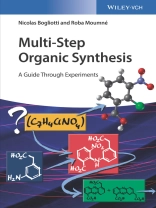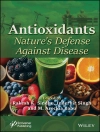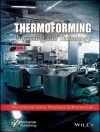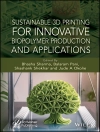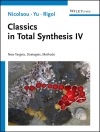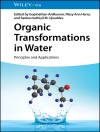Combining theoretical knowledge of synthetic transformations, practical considerations, structural elucidation by interpretation of spectroscopic data as well as rationalization of structure-property relations, this textbook presents a series of 16 independent exercises, including detailed descriptions of experimental procedures, questions, and answers. The experimental descriptions are very helpful for guiding less experienced students towards a better understanding of practical aspects in synthetic organic chemistry, while the broad scope of the questions and answers is excellent for learning purposes. The exercises are based on published research articles, adapted for didactic purposes, and will thus inspire students by way of having to solve real-life problems in chemistry.
A must-have for MSc and Ph D students as well as postdocs in organic chemistry and related disciplines, and lecturers and organizers of lab courses in organic chemistry.
Table des matières
Preface xi
List of Abbreviations xiii
1 Atovaquone: An Antipneumocystic Agent 1
Answers 4
References 8
2 SEN794: An SMO Receptor Antagonist 9
Answers 13
References 20
3 Synthesis of an H1–H3 Antagonist 21
3.1 Synthesis of Fragment 2 21
3.2 Synthesis of Fragment 3 26
3.3 Fragment Assembly and End of Synthesis 27
Answers 29
References 40
4 Synthesis of Eletriptan 41
Answers 45
References 50
5 Total Synthesis and Structure Revision of Streptophenazine A 51
Answers 54
References 59
6 Synthesis of Leiodermatolide, A Biologically Active Macrolide 61
6.1 Access to Fragment C 62
6.1.1 Preparation of Compound 2 62
6.1.2 Preparation of Compound 7 63
6.1.3 Preparation of Compound 12 63
6.1.4 Preparation of Fragment C 65
6.2 Access to Fragment D 65
6.2.1 Preparation of Compound 26 65
6.2.2 Preparation of Fragment D 66
6.3 Final Steps 67
6.3.1 Assembly of B and Formation of A by Ring‐Closing Alkyne Metathesis 67
6.3.2 Coupling of Sugar and Macrocycle 68
Answers 68
References 76
7 Azobenzene-Thiourea Catalysts for the Control of Chemical Reactivity with Light 77
7.1 Synthesis of Azobenzene-Thiourea Derivatives 77
7.2 Investigation of Catalytic Properties 82
Answers 85
References 92
8 Synthesis and Properties of a Photo-activatable Mimic of Pyridoxal 5ʹ-Phosphate 93
Answers 99
References 105
9 Fluorescent Peptides for Monitoring Activity of Autophagy-Initiating Enzyme 107
9.1 Solid-Phase Synthesis of a Putative Fluorogenic Peptide Substrate for ATG4B 107
9.2 Evaluation as Fluorogenic Substrates for ATG4B 108
9.3 Solution-Phase Synthesis of a Fluorogenic Substrate Analog Containing a Self-Immolating Linker 111
Answers 112
References 118
10 Fluorescent Peptide Probes for Cathepsin B 119
10.1 Solution Synthesis of a Water-Soluble Cyanine Fluorophore 119
10.2 Synthesis of a Water-Soluble Cyanine Fluorophore Using a Polymeric Support 121
10.3 Synthesis and Evaluation of Cyanine-Based NIR Peptide Probes for Monitoring Cathepsin B Activity 123
Answers 129
References 138
11 Total Synthesis of Stemoamide 141
11.1 Radical Approach to the Construction of the Tricyclic Core of Stemoamide 141
11.2 Formal Synthesis of (±)-Stemoamide 143
11.3 Enantioselective Total Synthesis of (−)-Stemoamide 145
Answers 148
References 158
12 Total Synthesis and Structure Revision of Caraphenol B 159
12.1 Synthesis of the Proposed Structure of Caraphenol B 159
12.2 Synthesis of the Revised Structure of Caraphenol B 162
Answers 164
References 170
13 Synthetic Routes Toward Muricatacin and Analogs 171
13.1 Synthesis of (+)-Muricatacin 171
13.2 Synthesis of (+)-epi-Muricatacin by Enantioselective Ketone Reduction 173
13.3 Synthesis of (−)-Muricatacin 176
Answers 178
References 187
14 Asymmetric Synthesis of (−)-Martinellic Acid 189
14.1 Preliminary Studies: Toward the Formation of a Model Tricyclic Compound 189
14.2 Synthesis of an Advanced Intermediate 192
14.3 Completion of the Synthesis 194
Answers 196
References 203
15 Cyclic Pseudopeptides as Potent Integrin Antagonists 205
15.1 Conformational Analysis 205
15.2 Synthesis of Bicyclic Lactam Templates 208
15.3 Solid Phase Peptide Synthesis 211
15.4 Pharmacological Study 214
Answers 215
References 224
16 Enantioselective Synthesis of Nonnatural Amino Acids for Incorporation in Antimicrobial Peptides 227
16.1 First Generation Mimetics: Synthesis and Biological Evaluation 227
16.2 Structural Analysis and Mechanism of Action 229
16.3 Sequence Optimization: Synthesis of Nonnatural Amino Acids 231
16.3.1 Synthesis of Homophenylalanine (Hfe) 231
16.3.2 Synthesis of Phenylglycine (Phg) 232
16.3.3 Synthesis of 4‐Chlorophenylalanine (Cl F) 234
16.3.4 Synthesis of 2‐Naphtylalanine (2‐Nal) 235
16.3.5 Synthesis of 1‐Naphtylalanine (1‐Nal) 235
16.3.6 Synthesis of Cyclohexylalanine (Cha) 236
16.3.7 Synthesis of Norleucine (Nle) 237
16.3.8 Synthesis of Biphenylalanine (Bip) 238
Answers 240
References 256
Further Reading 259
Index 261
A propos de l’auteur
Nicolas Bogliotti is Assistant Professor at Ecole normale superieure Paris-Saclay, France. After his undergraduate studies at Universite Nice Sophia-Antipolis, France, he obtained his MSc and Ph D Degrees at Universite Pierre et Marie Curie in Paris, France. He was a postdoc at ETH Zurich, Switzerland and Institut Curie, France, before his current position. His research interests focus on the synthesis of photosensitive molecules allowing visualization of recognition events, induction of a biological response and modulation of chemical reactivity.
Roba Moumne is Assistant Professor at Universite Pierre et Marie Curie, France. She studied chemistry and completed her MSc and Ph D at the same university. Before her current position, she was also a postdoctoral fellow at Max-Planck-Institut in Mulheim and der Ruhr, Germany, at University of Zurich, Switzerland and at Universite Paris Descartes, France. Her research interests include bioorganic chemistry and peptide synthesis.
